Reading the Saundarya Lahari – V
“When she, the supreme power, [becoming] by her own free will embodied as all that exists, perceives her own throbbing radiance, the chakra is then being produced.
The Heart of the Yogini Tantra
“I worship that goddess who is supreme Siva, whose form is the indestructable a-letter, manifesting the tides of the waves of the kulas.”
Nityasodasikarnava 1:10
And so to verse 11 – which all commentaries (at least the ones I’ve read) agree refers to the Sri Yantra:
“Nine base components –
four Sri-triangles and five Siva-triangles –
around a distinct center point
plus lotuses of eight and sixteen petals, three rings and three
bordering lines:
thus, altogether
Your angle-home evolves as forty-three.”
(transl. Francis X. Clooney, 2005)
I thought this would be an opportune moment to make a brief tour through the nine aravanas – “enclosures” – of the Sriyantra, beginning with the Bhupura and moving inwards towards the Bindu – this being the way of “enfoldment” – samhrti (as opposed to the progressive unfolding from Bindu outwards, which is known as srshti.)
Bhupura
 The “outer court” of the Sriyantra is usually referred to as the Bhupura – the earth-city, 1 earth-square, or earth-stretch. There is something of a disagreement amongst commentators on whether or not the “gates” of the Bhupura are open or closed 2. The Bhupura is commonly referred to as trailokyamohana – “[the] Enchanter of the three worlds” and its powers are called the prakata – “explicit” or “obvious ones”. In the schema I was taught, the presiding powers of the Bhupura are: on the outer line, the eight lokesvaras or world-protectors 3 – the guardians of the eight directions. On the middle line, the eight Siddhi Shaktis and on the innermost line, the eight Matrika Shaktis:
The “outer court” of the Sriyantra is usually referred to as the Bhupura – the earth-city, 1 earth-square, or earth-stretch. There is something of a disagreement amongst commentators on whether or not the “gates” of the Bhupura are open or closed 2. The Bhupura is commonly referred to as trailokyamohana – “[the] Enchanter of the three worlds” and its powers are called the prakata – “explicit” or “obvious ones”. In the schema I was taught, the presiding powers of the Bhupura are: on the outer line, the eight lokesvaras or world-protectors 3 – the guardians of the eight directions. On the middle line, the eight Siddhi Shaktis and on the innermost line, the eight Matrika Shaktis:
| Direction | Outer (Lokesvaras) | Middle (siddhi shaktis) | Inner (matrika shaktis) |
|---|---|---|---|
| E | Indra | Animashakti power of becoming small | Yogesvari Desire |
| SE | Agni | Vasitvashakti power to subjugate | Mahesvari Anger |
| S | Yama | Mahimashakti power of becoming heavy or self-magnification | Vaishnavi Greed |
| SW | Nirriti | Prakamyashakti power of accomplishment | Kaumari Delusion |
| W | Varuna | Laghimashakti power of becoming light, feather-like | Brahmani Egoity |
| NE | Vayu | Yatrakamavasayitvashakti power of effective will | Varahi Jealousy |
| N | Soma | Isitvashakti power of creative regulation | Mahalaksmi Merit |
| NW | Ishana | Pratpishakti power of self-extension | Chamunda Demerit |
These shaktis are ruled collectively by a form of Tripura-Devi. She is to be meditated upon as beautiful, the colour of crystal, four-armed, bearing a book, a pot and a lotus flower, and adorned with pearls.
There are many variants on this arrangement. According to the Tantrarajatantra for example, the ten siddhis dwell in the outer court, the middle court bears the eight matrikas, and in the inner court dwell the ten mudrashaktis. The eight matrikashaktis are sometimes identified with the bodily-constituents – skin with Brahmani, blood with Mahesvari, etc. The siddhishaktis may be visualised as red in hue, wearing red cloth, wearing the crested moon as a diadem, making with the left hand the gesture of assurance and holding in the right hand a wish-granting jewel. The matrikas are dark blue in hue, wearing red garments, holding a red lotus and a bowl filled with nectar. The mudrashaktis are said to be the colour of molten gold, and each bear the noose and the goad.
“Hail to the Peaceful Sentiment, Anima Siddhi, on the back of the right shoulder. ”
Bhaskararaya, Bashya
Bhaskararaya, in his commentary 4 on the Bhavanopanishad equates the nine rasas (actually ten, adding niyati – the power of constraint) with the siddhis. 5 Lalitambika is the embodiment of the rasas and it is through the sentiments or moods that the devotee may savour the grace of the goddess.
The Bhupura collectively can be understood as the bodymind complex and its primary transactions with the world.
three circles
Between the bhupura and the first group of triangles are three circles or girdles – trivrtta – of which there are a wide variety of interpretations. For example, Sivananda, in Subhagodayavasana equates the three to the three eyes or lights of the goddess – Moon, Sun, and Fire. Rao (1983, p53) states that according to the Dakshinamurti lineage, the outer girdle is composed of 29 matrikadevis, the middle girdle, 16 matrikadevis, and the inner girdle, the 15 nityadevatas – presided over by Kamesvari. According to Bhaskararaya, the three circles represent auspiciousness and serve to ornament 6 the powers dwelling within the srichakra.
Fulfiller of all desires
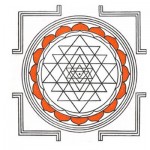 Within the three circles is a lotus of sixteen petals, known as Sarvasaparipuraka Chakra – “the fulfiller of all desires”. The Shaktis of this group are known as the Gupta – “Hidden Ones” (or “Concealed Ones”) and all bear the epithet karsini – an indication that they have the power of attraction or fascination. These shaktis can be profitably considered as affects – they both attract and give rise to intensifications of awareness.
Within the three circles is a lotus of sixteen petals, known as Sarvasaparipuraka Chakra – “the fulfiller of all desires”. The Shaktis of this group are known as the Gupta – “Hidden Ones” (or “Concealed Ones”) and all bear the epithet karsini – an indication that they have the power of attraction or fascination. These shaktis can be profitably considered as affects – they both attract and give rise to intensifications of awareness.
The Shaktis are: Kamakarsini – atttracting that which is desired; Buddhayakarsini – attracting discrimination; 7 Ahamkarakarsini – Attracting the “I”; Sabdakarsini – attracting sound; Sparsakarsini – attracting touch; Rupakarsini – attracting form; Rasakarsini – attracting taste; Gandhakarsini – attracting smell; Cittakarsini – attracting all prehensions; 8 Dhairyakarsini – attracting fortitude; Smrtyakarsini – attracting memory; Namakarsini – attracting names; Bijakarsini – fascinating seeds; 9 Atmakarsini – attracting the self; Amrtakarsini – attracting immortality; and Sarirakarsini – attracting the body.
This group of powers is sometimes referred to as the Nityakalas. They are identified with the five elements, the five organs of cognition, the five organs of action, and all the modifications of mind as the sixteenth element. They are also the sixteen vowels.
Brooks (1987, p306) gives an explanation by a contemporary SriVidya adept of the action of the Nityakalas:
“Kamakarsini means that whatever is desired will become available. The attractions of the senses have to do with these becoming pleasurable aspects of the adept’s experience but can also mean that he has this quality. For example, the Gandhakarsini means that the adept attracts such pleasurable fragrances, that he can smell things others cannot and that he himself always has a pleasant smell.”
Agitator of All
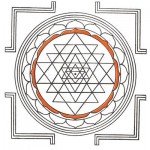 Next there is a lotus of eight petals, called Sarva Sanksobhana Chakra – “Agitator of All” (or “Exciter of all”). The eight shaktis residing within this lotus are known as Guptatara – “Very Secret” and bear the epithet ananga – “bodiless” or “limbless”. 10
Next there is a lotus of eight petals, called Sarva Sanksobhana Chakra – “Agitator of All” (or “Exciter of all”). The eight shaktis residing within this lotus are known as Guptatara – “Very Secret” and bear the epithet ananga – “bodiless” or “limbless”. 10
They are: Anangakusuma – Of infinite fire; Anangamekhala – Girdled by infinity; Anangamandana – Of infinite delight; Anangamadanatura – Of infinite delight in love; Anangarekha – Of infinite measure; Anangavegini – Of infinite flowing; Anangankusa – Of the infinite goad; and Anangamalini – Cultivator of infinity.
This circle of powers is presided over by Tripurasundari showing the gestures of dispelling fears and granting boons, smiling with passion and swaying, intoxicated with love.
Giver of all auspiciousness
 Now we come to the 14 triangles known as the Sarvasaubhagyadayakachakra – “Giver of all auspiciousness”. The fourteen shaktis dwelling therein all bear the epithet Sarva – “all” or “everything”. They are: Sarvasanksobhini – agitator of all; Sarvavidravini – power to disperse (or melt) all; Sarvakarsini – attractor of all; Sarvahladini – delighter of all; Sarvasamohini – enchanter (or deluder) of all; Sarvastambhini – sustainer of all; Sarvajrmbhini – expander (or releaser) of all; Sarvasankari – controller (or influencer) of all; Sarvanjini – pleaser of all; Sarvathasadhani – power to accomplish all aims; Sarvasampattipurini – power to fulfill all; Sarvamantramayi – power of all mantras; and Sarvadvandvaksayankari – power to destroy all dualities. All of these capacities can serve to attract or repel qualities. These shaktis are homologised with the 14 principle nadis of the body.
Now we come to the 14 triangles known as the Sarvasaubhagyadayakachakra – “Giver of all auspiciousness”. The fourteen shaktis dwelling therein all bear the epithet Sarva – “all” or “everything”. They are: Sarvasanksobhini – agitator of all; Sarvavidravini – power to disperse (or melt) all; Sarvakarsini – attractor of all; Sarvahladini – delighter of all; Sarvasamohini – enchanter (or deluder) of all; Sarvastambhini – sustainer of all; Sarvajrmbhini – expander (or releaser) of all; Sarvasankari – controller (or influencer) of all; Sarvanjini – pleaser of all; Sarvathasadhani – power to accomplish all aims; Sarvasampattipurini – power to fulfill all; Sarvamantramayi – power of all mantras; and Sarvadvandvaksayankari – power to destroy all dualities. All of these capacities can serve to attract or repel qualities. These shaktis are homologised with the 14 principle nadis of the body.
Accomplisher of all purposes
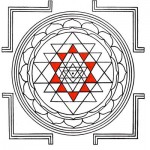 Moving inwards, there is the group of ten triangles called the Sarvathasadhakachakra – “the accomplisher of all purposes” or “the chakra that accomplishes the practitioner’s aims”. This group is presided over by Tripurasri, who shines with the radiance of ten thousand suns, holding forth a book and a rosary, and giving the gestures of granting boons and dispelling fears. Again, the epithets of the shaktis are all prefixed with Sarva. They are: Sarvasiddhiprada – bestowing all powers; Sarvasampatrada – bestowing all riches; Sarvapriyankari – [Who] makes all beloved; Sarvamangalakarini – [Who] makes all auspicious; Sarvakamaprada – [Who] confers all desires; Sarvadukhavimocini – remover of all suffering; Sarvamrtyuprasamani – [Who] migitates between all forms (and portents) of death; Sarvavighnanivarsini – [Who] removes all obstacles; Sarvangasundari [Who] is beautiful in all limbs; and Sarvasaubhagyadayini – [Who] imparts all prosperity.
Moving inwards, there is the group of ten triangles called the Sarvathasadhakachakra – “the accomplisher of all purposes” or “the chakra that accomplishes the practitioner’s aims”. This group is presided over by Tripurasri, who shines with the radiance of ten thousand suns, holding forth a book and a rosary, and giving the gestures of granting boons and dispelling fears. Again, the epithets of the shaktis are all prefixed with Sarva. They are: Sarvasiddhiprada – bestowing all powers; Sarvasampatrada – bestowing all riches; Sarvapriyankari – [Who] makes all beloved; Sarvamangalakarini – [Who] makes all auspicious; Sarvakamaprada – [Who] confers all desires; Sarvadukhavimocini – remover of all suffering; Sarvamrtyuprasamani – [Who] migitates between all forms (and portents) of death; Sarvavighnanivarsini – [Who] removes all obstacles; Sarvangasundari [Who] is beautiful in all limbs; and Sarvasaubhagyadayini – [Who] imparts all prosperity.
These powers preside over the ten principal forms of prana in the body.
Bestower of all protection
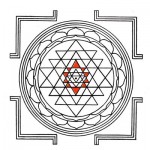 The next group of ten is known as the Sarvaraksakarachakra – “the bestower of all protection”. It is sometimes referred to as antardasara – “inner ten”- whereas the preceding group (above) is bahirdasara – “outer ten”. This group of shaktis are called nigarbha – a complex term which suggests that the “forms” of these yoginis or devas emerge from the radiance of Tripurasundari. They are presided over by Tripuramalini – the garlanded Tripura. According to the Lalitamahatmya these ten Nigarbhayoginis hold in their four arms the thunderbolt, javelin, iron club, and discus. They are: Sarvajnadevi – granting omniscience; Sarvashakti – granting all powers; Sarvaisvaryaprada – granting sovereignty; Sarvajnanamayi – granting all knowledge; Sarvavyadhivinasini – destroyer of all diseases; Sarvadharasvarupini – [the] form of all supports; Sarvapapahara – remover of all sins; Sarvandamayi – full of all bliss; Sarvaraksasvarupini– in the form of all protection; and Sarvepistaphalaprada – Conferring all desired fruits.
The next group of ten is known as the Sarvaraksakarachakra – “the bestower of all protection”. It is sometimes referred to as antardasara – “inner ten”- whereas the preceding group (above) is bahirdasara – “outer ten”. This group of shaktis are called nigarbha – a complex term which suggests that the “forms” of these yoginis or devas emerge from the radiance of Tripurasundari. They are presided over by Tripuramalini – the garlanded Tripura. According to the Lalitamahatmya these ten Nigarbhayoginis hold in their four arms the thunderbolt, javelin, iron club, and discus. They are: Sarvajnadevi – granting omniscience; Sarvashakti – granting all powers; Sarvaisvaryaprada – granting sovereignty; Sarvajnanamayi – granting all knowledge; Sarvavyadhivinasini – destroyer of all diseases; Sarvadharasvarupini – [the] form of all supports; Sarvapapahara – remover of all sins; Sarvandamayi – full of all bliss; Sarvaraksasvarupini– in the form of all protection; and Sarvepistaphalaprada – Conferring all desired fruits.
Remover of all diseases
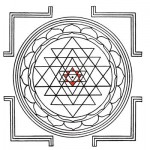 Within this enclosure – known as Sarvarogaharachakra – are the eight deities of speech – the vagdevatas: Vasini, Kamesvari,Modini, Vimala, Aruna, Jayani, Sarvesvari and Kaulini. These deities emit the entire alphabet (for example, Vasini presides over the sixteen vowels). The deities are regarded as rahasya – “secret” – indicating that they cannot be readily perceived. They act to remove the distinction the knower, the known, and the transactive process of knowing – thus collapsing all dualities – i.e. the root cause of dis-ease in the world 11. They are also identified with the yoginis who preside over the eight bodily centres – dakini, rakini, lakini etc., and with the eight dhatus (seven plus their aggregate); also the qualities of cold, warmth, happiness, unhappiness, desire (signifying all intentions and appetites) – the five mahabhutas – and the three gunas: sattva, rajas and tamas. 12
Within this enclosure – known as Sarvarogaharachakra – are the eight deities of speech – the vagdevatas: Vasini, Kamesvari,Modini, Vimala, Aruna, Jayani, Sarvesvari and Kaulini. These deities emit the entire alphabet (for example, Vasini presides over the sixteen vowels). The deities are regarded as rahasya – “secret” – indicating that they cannot be readily perceived. They act to remove the distinction the knower, the known, and the transactive process of knowing – thus collapsing all dualities – i.e. the root cause of dis-ease in the world 11. They are also identified with the yoginis who preside over the eight bodily centres – dakini, rakini, lakini etc., and with the eight dhatus (seven plus their aggregate); also the qualities of cold, warmth, happiness, unhappiness, desire (signifying all intentions and appetites) – the five mahabhutas – and the three gunas: sattva, rajas and tamas. 12
Lalita’s weapons
Hail to the lower part of the heart triangle, the Five Substances of the Senses, the All-Piercing Arrows.
Hail to the right part of the heart triangle, the Mind, the All Deluding Bow.
Hail to the upper part, Attraction, the All Subjugating Noose.
Hail to the left part, Repulsion, the All Paralysing Goad.
Bhaskararaya, Bashya
Within the seventh enclosure, and on the periphery of the eighth enclosure are arrayed the weapons of the goddess – the sugarcane bow, the five flower-arrows, the goad and the noose. 13 These Ayudha devatas are sometimes depicted by their seed-syllables, and at others as deities, with the weapon above their heads, and making the gestures of assurance and bestowing boons. In some texts, the arrows are placed in the West, bow in the North, noose in the East, and goad in the South. However, an alternative arrangement is to place the bow & arrows behind the triangle (as the devotee faces the yantra); the noose on the left, and the goad on the right. Following this schema, the bow and arrows can be said to be Kriyashakti – the power of action; the noose Icchashakti – the power of desire/will; and the goad Jnanashakti – the power of knowledge.
Bestower of all perfection
 The eighth aravana is the triangle called mulatrikona – as it is regarded as the very form of the goddess, out of which all other angles are extensions or reflections. This enclosure is known as Sarvasiddhiprada – “bestower of all perfection”. Residing within are Kamesvari (East); Vajresvari (South) and Bhagamalini (North). 14 This triad have many associations – such as the three gunas, the three great lights: Fire (Agni), Sun (Surya) and Moon (Chandra); the three processes – creation-maintenance-dissolution; the three pithas – Kamarupa, Purnagiri and Jalamdhara.
The eighth aravana is the triangle called mulatrikona – as it is regarded as the very form of the goddess, out of which all other angles are extensions or reflections. This enclosure is known as Sarvasiddhiprada – “bestower of all perfection”. Residing within are Kamesvari (East); Vajresvari (South) and Bhagamalini (North). 14 This triad have many associations – such as the three gunas, the three great lights: Fire (Agni), Sun (Surya) and Moon (Chandra); the three processes – creation-maintenance-dissolution; the three pithas – Kamarupa, Purnagiri and Jalamdhara.
Arrayed around the mulatrikona are the fifteen Nityas (plus the sixteenth – Sadakhya – who is one with Mahatripurasundari. 15 The Nityas each have their own mantras, yantras and subsidiary shaktis.
Bindu
“To this day, even the gods know not a thing about she who is meditated on in both embodied and formless aspects – ‘What [is she]?’, ‘From where [did she arise]?’, ‘Where [does she reside]?’, ‘By what [was she created]?’ [the gods ask].”
Nityasodasikarnava, 1.9
The ninth, and final enclosure 16 is called Sarvanandamayachakra – “Filled with all bliss “. Herein dwells the supreme form of the goddess Mahatripurasundari – transcendent; all-encompassing; from her rays the entire universe is emitted, sustained, and withdrawn. She is Kamesvari, seated on the lap of Kamesvara – Siva-Shakti in eternal, nondifferentiated delight. She is Rajarajesvari – “Queen of queens”. She is Lalita – “lokan atitya lalate” – [She who] surpasses the worlds that shine from her.
When visualised as a meru – a three-dimensional structure, the bindu is the peak to which the devotee ascends. It is sometimes correlated with the brahmandrapadma centre at the top of the skull.
The eight powers of the mulatrikona and Kamesvari are identified with the nine Yonis (“wombs”) which emit the phenomenal world – all of the samskaras which is the play of the goddess.
I have left a good deal out here, for reasons of (relative) brevity and any mistakes in interpretation are mine alone. Thanks are due to Vishvanath for his continued support and wisdom, without which I would never have attempted to get to grips with Sri Vidya.
Sources
Arthur Avalon Kamakalavilasa by Punyanandanatha with the Commentary of Natanandanatha (Ganesh & Co., 1922)
Douglas R Brooks The SriVidya School of Sakta Tantrism: A Study of the Texts and Contexts of the Living Traditions in South India (Ph.D thesis, Harvard University, 1987)
Douglas R Brooks The Secret of the Three Cities: An Introduction to Hindu Sakta Tantrism (University of Chicago Press, 1990)
Douglas R Brooks Auspicious Wisdom: The Texts and Traditions of Srividya Sakta Tantrism in South India (SUNY, 1992)
Gudrun Bühnemann, Mandalas and Yantras in the Hindu Traditions (Brill, 2003)
Francis X Clooney Divine Mother, Blessed Mother: Hindu Goddesses and the Virgin Mary (Oxford University Press, 2005)
Meera Kachroo, The Goddess and Her Powers: The Tantric Identities of the Saundarya Lahari (MA Thesis, McGill University, June 2005)
Jeffrey S Lidke The Goddess within and beyond the three cities: Sakta Tantra and the paradox of power in Nepala-Mandala (Ph.D Thesis, University of California, 2000)
Mike Magee, Mysteries of the Red Goddess: Vamakeshvarimata (Kindle edition, 2012)
S K Ramachandra Rao, The Tantra of Sri-Chakra (Bhavanopanishat) (Sharada Prakashana, 1983)
S. Shankaranarayanan Sri Chakra (Samata Books, 2002)
online
Bhavana Upanishad and Prayoga
the fifteen Nityas
The Yogini Hridaya
Notes:
- In Indian poetry (in particular, Kavya literature) cities and royal palaces are often portrayed as sites of opulence, wealth and grandeur, places of diverse wonders and delights -and in the center dwells the king, queen, or deity. Cities are often likened to beautiful women. ↩
- see Brooks, 1992, p140 for discussion ↩
- also lokapalas. ↩
- See Bhavana Upanishad and Prayoga translated by Mike Magee. ↩
- see here for some preliminary remarks on rasas. ↩
- see Reading the Saundarya Lahari III for some discussion of ornamentation. ↩
- See note on buddhi. ↩
- Cit is frequently translated as “mind”, “mind-stuff”, or “consciousness”. This is tricky however. Sir John Woodroffe, in his The World as Power (1922) pointed out that there is no exact English equivalent for Cit. He writes of Cit as the “common source and basis of Mind and Matter …. the infinite Whole in which all that is finite, whether as Mind or Matter, is.” Jaideva Singh, in his Pratyabhijnahrdayam (1998) translates Cit as consciousness, but remains unsatisfied with this solution. He points out that: “Consciousness connotes subject-object relation, knower-known duality. But Cit is not relational. It is just the changeless principle of all changing experience. It is Parasamvit. It has, so to speak, the immediacy of feeling where neither the “I” not the “This” is distinguished. I have, unsatisfactory though it may be, borrowed Whithead’s term prehension. ↩
- i.e. Bijas. ↩
- This can be taken as a reference to Kama as “ananga” is one of his epithets. See this post for some related discussion. ↩
- i.e. avidya – ignorance. ↩
- a brief note on the gunas ↩
- see the sugarcane bow for some related discussion. ↩
- Brooks (1992, p124) gives the three goddesses as Vama, Jyestha and Raudri. ↩
- see Mike Magee’s The Red Goddess for more details. ↩
- although, strictly speaking, it is not really an enclosure, but the point into which the three powers of the trikona coalesce or unfold from. ↩


One comment
Mike Magee
Posted July 13th 2013 at 8:02 am | Permalink
Nice little pictures of Shri Yantra avaranas. Took me ages to do those